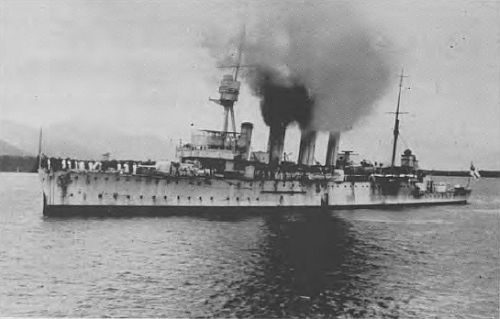- Author
- Sullivan, John
- Subjects
- WWII operations, WWI operations
- Tags
-
- RAN Ships
- HMAS Sydney I, HMAS Sydney II
- Publication
- September 1991 edition of the Naval Historical Review (all rights reserved)
November is an important month in Australian naval history, but this article deals with just two events which occurred in that month. Both relate to HMAS SYDNEY, the first involving the WW I cruiser of that name, and the second concerning the WW II cruiser of the same name. For good measure we will throw in an action which occurred in July in which the second SYDNEY also took part. Last year saw the 50th anniversary of the July action, which was almost totally ignored by the nation’s newspapers and electronic media.
The main armament of both ships consisted of 8 x 6″ guns, but where SYDNEY (1) had hers in 8 single mounts, with an available broadside of 5, SYDNEY (2) had 4 x twin turrets, with much more efficient weapons, and she could use all 8 in a broadside. SYDNEY (1) was 457 feet in length, her displacement was 5,400 tons, and she could raise 25 knots. SYDNEY (2) was 98 feet longer at 555 feet, she displaced 6,830 tons, and her top speed was 32½ knots.
Space precludes me from giving full details of the three actions in this story, but these are fully documented in other publications. In any case they are all well-known actions, and most of our readers are no doubt aware of the details.
The purpose of the story is just to bring the events to mind again, “lest we forget”.

The event involving SYDNEY (1) is, of course, her destruction of the German cruiser SMS EMDEN, which took place on 9th November, 1914. At that time the Royal Australian Navy was three years of age, and in fact, apart from HMA Ships PARRAMATTA and YARRA, in the first two years of its life the fledgling RAN consisted only of a few elderly and outdated ships left over from the Colonial navies which had become the Commonwealth Naval Forces after Federation. The victory of SYDNEY over EMDEN was therefore very important from the point of view of morale both in the RAN and at home. It was also vital for strategic reasons, as EMDEN had been a very successful raider. She sank or captured 23 ships in her brief career, and at one stage no less than 78 warships of the British, Australian, French, Russian and Japanese navies were actively seeking her.
EMDEN’s commanding officer, Captain Karl von Mueller, now planned to destroy the radio-telegraph station on Direction Island in the Cocos (Keeling) Islands. At dawn on 9th November, he anchored off the entrance to Port Refuge, and two cutters with the landing party aboard were towed the two miles to the jetty by EMDEN’s steam launch. Whilst this was happening the officer in charge of the telegraph station was busy sending off signals advising that he was about to be attacked.
SYDNEY was part of the naval escort for the first Anzac troop convoy to England. There were 38 transports and four escorts, HMS MINOTAUR (an armoured cruiser), IBUKI (a Japanese battlecruiser), SYDNEY and her sister-ship HMAS MELBOURNE. MINOTAUR was in command, and the convoy sailed from Western Australia on 1st November. On 8th November, MINOTAUR was detached from the convoy and MELBOURNE became senior ship. The next day the signals from Direction Island were received, and SYDNEY was ordered to investigate.
When SYDNEY and EMDEN sighted each other, von Mueller thought SYDNEY to be HMS NEWCASTLE, which carried only 2 x 6″ and 10 x 4″ guns against EMDEN’s 10 x 4.1″ main armament. This possibly influenced von Mueller to fight – if he had known right from the outset that he faced an enemy who out-gunned him he might have tried to flee. Nevertheless he went into battle short by 3 officers and 47 men, as there was no time to bring the landing party back on board. SYDNEY was commanded by Captain (later Vice-Admiral) J.C.T. Glossop, R.N., who intended to open fire at a range of 9,500 yards, which he and his gunnery officer believed was outside the range of EMDEN’s guns. However, EMDEN’s gunnery officer knew that by elevating his guns to 30° he could achieve a range of 10,500 yards as against the normal range of 9,000 yards. EMDEN therefore opened fire long before SYDNEY expected her to do so, but although EMDEN scored some hits no major damage was done. SYDNEY then proceeded to “knock the stuffing” out of EMDEN, which was beached by von Mueller on North Keeling Island, partly to try to save what was left of his crew, but also to prevent SYDNEY actually sinking his ship. The effect was the same, whether she was sunk or beached as a total wreck.




